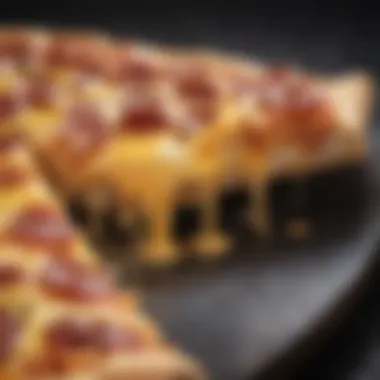Optimal Cheese Selection for Perfect Pizza


Intro
Selecting the right cheese for pizza is a delicate and intricate endeavor. Cheese contributes significantly to the final flavor profile and texture of the pizza. This section emphasizes the technical aspects that should be considered when making a cheese choice. Understanding each cheese's meltability, stretchability, flavor nuances, and how they pair with various toppings is crucial. Both traditional and modern chees alternatives will be discussed, allowing pizza enthusiasts to make informed decisions. It’s not just about taste; it’s about crafting a complete experience. Choosing the proper cheese can elevate a simple dish into a culinary masterpiece that resonates with flavor and texture.
The Importance of Cheese in Pizza
Cheese plays an essential role in the pizza-making process. The correct cheese can enhance the overall taste, offer exceptional mouthfeel, and create visual appeal. Mozzarella is often the go-to cheese for pizza, thanks to its meltability and creamy texture. However, exploring alternatives opens a world of possibilities. Ingredients can change not only the flavors but also the character of the dish. For example, cheddar, gorgonzola, and even goat cheese can add unique attributes.
"The right cheese not only complements the toppings but also deepens the pizza experience."
Factors in Cheese Selection
When selecting cheese for pizza, consider the following factors:
- Meltability: This refers to the ability of cheese to melt smoothly when heated. Some cheeses may separate or become rubbery.
- Stretch: Stretchy cheese can enhance the visual appeal. This quality is central to the pizza experience.
- Flavor Profile: Each cheese brings its unique tastes. The cheese should complement but not overpower the other ingredients.
- Pairing: Different cheeses go well with various toppings. Knowing these combinations can enrich the end product.
Types of Cheese for Pizza
- Mozzarella: The classic choice. Known for its high moisture content, mozzarella melts well. Its mild flavor acts as a backdrop for other toppings.
- Provolone: This cheese adds a sharpness without being overwhelming. It pairs well with spicy toppings.
- Ricotta: A creamy cheese that can bring richness. It is usually dolloped on rather than melted.
- Parmesan: Adds a salty kick. It is often used as a finishing touch.
- Gorgonzola: A blue cheese that lends a distinct flavor. It pairs well with sweet ingredients, like figs or caramelized onions.
By understanding these aspects of cheese selection, pizza makers can experiment and create a range of appealing pizzas. Using different cheese combinations can also lead to excellent results; indeed, the pizza world is rich with flavor awaiting exploration.
Finale
Selecting the optimal cheese for pizza is paramount. It requires attention to detail and an understanding of both traditional and contemporary options. In the later sections, we will continue to explore specific recipes and techniques that incorporate these cheeses effectively. Through this journey, pizza lovers will gain the knowledge needed to elevate their creations.
Prolusion to Pizza Cheese
Cheese serves as a foundational element in pizza. Its role is not merely functional but also essential for flavor and texture. The type of cheese chosen can significantly impact the overall pizza experience. A thorough understanding of pizza cheese can vastly enhance the outcome of homemade or commercially prepared pizzas.
In this section, the focus will be on the different aspects of cheese in pizza. The various qualities that make cheese suitable for pizza will be explored. Additionally, the diversity of cheese choices and the implications of these choices will be discussed. Knowing why cheese is important helps in making informed selections, ensuring optimum satisfaction.
Importance of Cheese in Pizza
Cheese contributes to the aroma and mouthfeel of pizza. It melts during cooking, creating a desirable gooey texture. This texture influences how the pizza is consumed and perceived. Moreover, cheese holds the toppings in place, enhancing the stability of each slice. The flavor profile of cheese complements sauces and toppings, forging harmony in the dish.
Choosing the right cheese means considering meltability and flavor pairing. Various cheeses bring distinctive tastes and textures, which can either enhance or clash with other ingredients. Therefore, cheese selection should be intentional rather than arbitrary.
Cultural Variances in Cheese Usage
Different cultures have distinct approaches to cheese usage in pizza. In Italy, the classic choice is mozzarella, often paired with simple ingredients like tomatoes and basil. This reflects the Italian philosophy of showcasing quality ingredients rather than overcomplicating flavors.
Conversely, in the United States, toppings and cheese blends are varied and often extravagant. Cheddar is frequently used alongside mozzarella, providing a sharper flavor. This type of fusion emphasizes a different gastronomic ideology where quantity and bold combinations take center stage.
Internationally, variations can be found in places like Brazil, which might use catupiry cheese, lending a unique creaminess. Each region's history and tastes shape its pizza. Understanding these differences expands the appreciation of pizza and its many forms.
"Cheese is at the heart of pizza, elevating it from simple bread to a culinary delight."
By exploring the importance and cultural variances in cheese, we pave the way for deeper insights into optimal cheese selection, which will be discussed in subsequent sections.
Key Cheese Characteristics for Pizza
When it comes to selecting cheese for pizza, the right characteristics can elevate a simple dish into a remarkable culinary experience. Three primary factors play significant roles in this selection process: meltability, flavor profile, and stretchiness. Understanding these factors not only helps create the perfect pizza but also ensures satisfaction for those indulging in this beloved dish.
Meltability


Meltability refers to how cheese reacts to heat during cooking. A cheese that melts properly contributes to that luscious, gooey texture that pizza lovers crave. Several cheeses have high meltability, including mozzarella, one of the most popular choices. This cheese melts evenly and stretches beautifully, making it a staple in pizzerias worldwide.
Cheeses with lower meltability can result in a less enjoyable pizza experience. For example, some aged cheeses, while flavorful, may not melt well. Therefore, when selecting cheese, it is crucial to consider the heat sensitivity of different cheese varieties. A good rule of thumb is to choose semi-soft to soft cheeses to achieve optimal meltability. The importance of this characteristic cannot be overstated; the right melting cheese creates a harmonious blend with the crust and toppings, enhancing overall enjoyment.
Flavor Profile
The flavor profile of pizza cheese significantly influences the overall taste of the dish. Different cheeses offer varying levels of sharpness, creaminess, and saltiness, which all add to the complexity of flavors. As an example, mozzarella has a mild and creamy flavor, which makes it an ideal base for more robust toppings. In contrast, cheddar provides a sharper taste, bringing a distinct character to the pizza.
When evaluating the flavor profile, one should also consider any additional ingredients in the pizza. Ingredients such as fresh herbs or spicy toppings can alter the flavor balance. A well-selected cheese not only complements but also enhances these flavors, creating a more cohesive and satisfying pizza. Therefore, the ability to harmonize flavors through cheese selection is key in mastering the art of pizza making.
Stretchiness
Stretchiness is another desirable quality in pizza cheese, particularly associated with mozzarella. This characteristic appears when the cheese is heated and pulled apart, creating beautiful, long strands. The right amount of stretchiness is essential, as it provides that iconic visual appeal and texture.
Different cheeses vary in their stretchiness. For example, mozzarella di bufala stretches more than low-moisture mozzarella, offering a different experience. Ultimately, the ideal cheese selection balances meltability and stretchiness without sacrificing flavor. Cheeses suitable for stretching can significantly enhance the pizza experience by adding a dynamic texture to the first slice.
"Selecting the right cheese transforms a basic pizza into a delightful gastronomic experience."
Comparative Analysis of Cheeses
Understanding the Comparative Analysis of Cheeses is crucial for anyone looking to enhance their pizza experience. Selecting the right cheese can significantly impact the flavor, texture, and overall satisfaction derived from pizza. This section explores various types of cheeses commonly used on pizza, allowing readers to evaluate their distinct characteristics. Each cheese not only brings unique qualities to the table but also caters to different preferences and regional influences. By recognizing these elements, pizza enthusiasts can make informed decisions tailored to their taste and occasion.
Mozzarella: The Classic Choice
Mozzarella is arguably the quintessential cheese for pizza. Its origins trace back to Italy, where traditional recipes often feature fresh, high-moisture mozzarella. This cheese is renowned for its meltability and stretchiness, both of which are essential for that iconic pizza pull. When melted, mozzarella forms a gooey layer that enhances the overall texture of the dish. Furthermore, its mild flavor complements a variety of toppings without overpowering them.
Popular brands like Galbani offer mozzarella that stays true to the authentic Italian craftsmanship, giving pizza lovers a taste of tradition. Whether you opt for fresh mozzarella or the low-moisture variant, the key is to choose a type that melts beautifully while still maintaining its structure.
Cheddar: A Bold Alternative
Cheddar cheese introduces a bold flavor profile that can add a distinctive twist to pizza. This cheese has a firmer texture than mozzarella and a sharper taste, which many find appealing. It's an excellent choice for those who seek to experiment with their pizza creations. Cheddar can stand up to bolder toppings, such as barbecue chicken or spicy sausage, making it a versatile option.
Moreover, combining cheddar with mozzarella can create a harmonious blend where the creaminess of mozzarella balances the sharpness of cheddar. Brands like Tillamook provide excellent cheddar that melts well and adds depth to the flavor.
Parmesan: For Depth of Flavor
Parmesan cheese serves as a fantastic finishing touch for pizza. Its nutty and salty flavors can elevate simple pizzas to something remarkable. While it does not melt in the same way as mozzarella, it easily garnishes pizzas, adding an attractive appearance and a burst of taste.
Sprinkling freshly grated Parmesan Reggiano over a hot pizza just before serving allows it to slightly melt, infusing each bite with robust flavor. This cheese represents an ideal option for individual preferences towards a more complex taste without dominating the classic pizza base.
Feta and Its Unique Profile
Feta cheese offers a unique salty tang that can significantly influence a pizza's character. This cheese shines particularly in vegetarian pizzas or Mediterranean-style variations. The crumbly texture of feta allows for even distribution over the dough, adding pops of flavor across each slice. Suitable toppings include olives, spinach, and sun-dried tomatoes, all of which harmonize beautifully with feta.
Feta's lower meltability compared to mozzarella means it won't create the same stretchy effect; however, its tangy profile provides a memorable taste experience. Using brands like Dodoni ensures a high-quality feta that enhances your pizza.
Gorgonzola: A Blue Option
Gorgonzola is an example of a blue cheese that can add an adventurous flair to pizza. Known for its strong, pungent flavor, gorgonzola can transform a simple pizza into an extraordinary dish. This cheese works especially well in gourmet pizzas, where it can be complemented with ingredients like pears, walnuts, or fig preserves.
Its rich, creamy texture contrasts impressively with the crispness of baked crust. While it may not be for everyone due to its bold taste, for those willing to explore, gorgonzola presents an exciting option to experiment with.
"The choice of cheese can redefine not only a pizza's flavor but also the entire dining experience."
Blending Cheeses for Optimal Results


Blending cheeses for pizza can significantly elevate the eating experience, embracing both taste and texture. It is not enough to solely rely on one type of cheese for finishing your pizza. Each cheese carries unique characteristics that can complement one another. This section explores why blending cheeses is important, emphasizing the benefits and considerations needed.
Combining Flavors and Textures
When considering different cheeses, one must appreciate the role of flavors and textures that each type brings. Mozzarella serves as the base, contributing creaminess and elasticity. On the other hand, Parmesan offers a sharp, nutty note that contrasts nicely with the mildness of mozzarella. By combining these two, you achieve a balance that creates a multi-dimensional flavor profile.
Moreover, textures matter greatly in a pizza. A crisp, crunchy crust paired with melting, gooey cheese sets the perfect stage. Pairing Gorgonzola with mozzarella not only introduces an exciting tang but also a creamy texture that enhances mouthfeel. Thus, varying textures lead to a more enjoyable pizza.
Popular Cheese Blends
Several common cheese blends have been established over time, each catering to different tastes and cultural preferences:
- Mozzarella and Cheddar: A popular choice in the United States, this blend brings a cheesy richness while keeping the melted base soft.
- Mozzarella and Feta: This Greek-inspired blend is perfect for Mediterranean pizzas. It adds a salty, tangy element to the dish.
- Mozzarella and Provolone: This combination enhances the traditional pizza experience with slightly sharper flavors while maintaining that delightful melt.
- Fontina and Gruyère: For those seeking a gourmet twist, blending these two offers an elevated taste while forming a rich, creamy layer.
Consider your toppings when choosing cheese blends. Certain cheeses enhance specific ingredients, resulting in a more cohesive flavor experience.
Blending cheeses for pizza is an art that requires skill, imagination, and awareness of how textures interact. The right combinations can transform an ordinary pizza into a culinary delight.
Regional Cheese Preferences
The choice of cheese can greatly vary depending on the region, influencing not just flavor but also texture and overall pizza experience. Understanding regional cheese preferences is vital for anyone aiming to create a pizza that resonates deeply with local tastes and traditions. In Italy, for example, the emphasis may be on fresh mozzarella, while American styles might highlight a combination of cheeses, including cheddar and provolone. This section delves into the distinct cheese choices from Italy and the innovative techniques embraced by American bakers.
Italian Traditions
In Italy, cheese choices are deeply rooted in traditions and the history of pizza-making. The most notable cheese is mozzarella, particularly the buffalo variety from Campania. This cheese offers a creamy texture and excellent meltability, making it ideal for traditional Neapolitan pizza. When using Italian cheeses, one should consider the freshness and sourcing. Many Italian chefs prioritize local, high-quality ingredients.
Another significant choice in Italy is pecorino, which brings a salty and sharp flavor to the pizza. It is often used for grating and adds richness when combined with other cheeses. Gorgonzola, a blue cheese, is also popular in certain regions and adds a strong, distinct taste that pairs well with sweet toppings like figs or pears. Incorporating these elements can elevate a pizza beyond the ordinary into a realm of authenticity sought by purists.
American Innovations
American pizza has evolved into a unique culinary art, marked by diverse cheese selections and innovative combinations. In the U.S., cheeses such as cheddar, Monterey Jack, and even cream cheese have found their way into various pizza recipes. Cheddar, with its bold flavor and sharpness, often serves as a base that amplifies the taste profile when paired with meats.
Moreover, American pizza chefs frequently experiment with blending different cheeses. A typical example is a blend of mozzarella and provolone to enhance the stretch and melt while adding depth of flavor. This regional preference for blending can be seen in many pizzerias that offer unique cheese mixes tailored to local tastes.
The beauty of American pizza innovation lies in its flexibility. Culinary artists continue to push boundaries, creating gourmet pizzas that explore flavors from different cultures, while maintaining a pizza's core elements.
The acceptance of non-traditional cheeses has led to a cultural melting pot of flavors, making American pizza a canvas for culinary experimentation. Thus, understanding regional preferences not only enriches the pizza-making process but also pays homage to the diverse heritage of this beloved dish.
Considerations for Home Baking
When it comes to making pizza at home, cheese selection is a crucial aspect that can significantly influence the final product. Understanding the specific needs of your baking environment and method will help ensure that you achieve the desired results. Beyond just taste, the right cheese contributes to texture and overall pie performance.
The benefits of selecting appropriate cheese cannot be overstated. A well-chosen cheese enhances both flavor and melt quality, leading to a delicious outcome. Moreover, being aware of several considerations will help in deciding between store-bought options or creating your own cheese from scratch.
Selecting Store-Bought Cheeses
When opting for store-bought cheeses, it is essential to consider freshness and quality. Many produce great offerings, but brands vary widely. Look for mozzarella brands with high moisture content for optimal meltability. Fresh mozzarella works best, but if that is not available, part-skim mozzarella is a reliable alternative with good characteristics.
Pay attention to the label. Specifically seek cheeses that contain whole milk, as these typically yield better results. Avoid products with added starches or preservatives, which can impact meltability. If you are looking for additional flavors, consider blends that incorporate provolone or asiago for a more complex taste.
Here are some tips when browsing:
- Check the expiration date for freshness.
- Opt for cheese packed in water to retain moisture.
- Experiment with different brands to find your preferred taste.
Making Cheese from Scratch


For the adventurous, making cheese at home allows for customization to match personal preferences. The most straightforward option is ricotta, which requires few ingredients and minimal equipment. With some practice, more complex cheese types can be created, such as mozzarella.
Making cheese from scratch gives one full control over texture and flavor, allowing for a highly personalized pizza experience. In addition, homemade cheese typically has fewer additives than many store-bought options.
Here’s a simple recipe for homemade ricotta:
Storage Tips for Cheese
Proper storage is key in maintaining the quality of cheese. Cheese should be kept in a cool, dry place, ideally in a temperature-controlled environment. If using store-bought cheese, always check how much you need to use. If there are leftovers, packaging them properly is essential.
For best results, wrap cheese tightly in wax paper, followed by plastic wrap or aluminum foil. This method helps control moisture. For larger blocks, consider slicing the cheese only as needed, which helps in maintaining freshness.
Additionally, be mindful of how long cheese has been in your refrigerator. Most cheeses are best if consumed within a week or two of opening. Moldy cheese might still be usable, but it’s better to taste before using it in your pizza.
In summary, when making pizza at home, cheese selection is a decision steeped in both culinary traditions and personal preference. By considering store-bought options, the benefits of making cheese from scratch, and essential storage practices, one can elevate their pizza's quality significantly.
Common Mistakes in Cheese Selection
Understanding common mistakes in cheese selection is crucial for pizza enthusiasts. Mistakes can lead to poor flavor, unpleasant textures, and overall disappointing pizza experiences. This section highlights errors that both home bakers and professional chefs frequently make when choosing cheese for their pies. Recognizing these mistakes ensures that one can make informed decisions that result in superior pizza.
Using Low-Quality Cheeses
Opting for low-quality cheeses is perhaps the most significant mistake a pizza maker can make. Many believe that all cheeses will melt and taste the same once baked on a pizza. This misconception can entirely diminish the potential of the dish. Quality cheese tends to have a higher fat content, which contributes to better meltability and a richer flavor profile.
Low-quality cheeses often contain fillers and preservatives. These ingredients can negatively affect the texture and melting characteristics. Instead of achieving that desired creamy texture, low-quality cheeses might become rubbery or greasy.
For an optimal pizza experience, it’s advisable to invest in artisanal cheeses or known brands that prioritize quality in their products. Cheeses like fresh mozzarella or aged provolone may cost a bit more, but their flavors and textures significantly elevate the pizza's overall sensory experience.
Neglecting Melt Characteristics
Another frequent error is failing to consider the melting characteristics of the chosen cheese. Not all cheeses melt well, which can lead to a subpar pizza experience. Cheeses that do not melt adequately can create an unappetizing layer on top of the pizza, rather than blending harmoniously with the other ingredients.
When selecting cheese, assessing melt characteristics involves looking at moisture content and fat composition. For instance, mozzarella is known for its excellent meltability and stretchiness, making it a preferred choice for traditional pizza. On the other hand, cheeses like feta do not melt in the same way. While their sharp and tangy flavor can add to the pizza, using them as a primary cheese can lead to disappointment.
"Choosing the right cheese is as critical as selecting the perfect toppings. Ignoring melt characteristics can render the entire pizza experience flat and uninspired."
Summary
In summary, avoiding low-quality cheeses and paying attention to melt characteristics are essential steps in the pizza-making process. A thoughtful selection will result in a delightful pizza that showcases the best flavors and textures. Cheese selection should be treated with the seriousness it deserves, as it is one of the foundational components of this beloved dish.
End: Choosing the Right Cheese
Selecting the right cheese for pizza is far more than a personal preference—it's a blend of science and art that directly impacts the final product’s taste, texture, and overall experience. This article has highlighted the essential elements involved in this selection process, emphasizing the importance of understanding cheese characteristics like meltability, flavor profile, and stretch. The right cheese selection can elevate a pizza from mediocre to extraordinary, reinforcing why it deserves careful consideration.
Benefits of Thoughtful Cheese Selection
Choosing the optimal cheese not only fulfills the aesthetic appeal of a pizza but also caters to different palates. Well-considered cheese choices enhance the flavors of toppings, creating a harmonious balance in every bite. Mozzarella, known for its meltability, provides that iconic cheesiness, while incorporating other cheeses, such as cheddar or gorgonzola, can introduce richness and depth.
- Meltability: The ability of cheese to melt uniformly affects both the visual and taste aspects. High-quality cheese melts beautifully, covering the surface of the pizza evenly.
- Flavor: Different cheeses have distinct flavors. A good blend can accentuate or complement the flavors present in other toppings.
- Functionality: Cheese must not only taste good but also contribute to the structure of the pizza, ensuring slices hold together when served.
To sum up, a thoughtful approach to cheese selection enriches the pizza-making experience. Paying attention to the specific qualities of the cheese can lead to delightful results that satisfy diverse tastes.
Final Thoughts on Cheese Selection
The journey of selecting cheese for pizza combines knowledge, experimentation, and an appreciation for quality.
When anticipating the perfect pizza experience, one should remember:
- Explore various cheese types and their characteristics.
- Be open to experimenting with blends for unique flavors.
- Prioritize quality over quantity; high-quality cheese can significantly impact taste and satisfaction.
As you choose your cheese, consider how it interacts with other ingredients. This approach forms the basis for creating memorable pizza experiences. A well-selected cheese not only enhances flavor; it is the cornerstone of what distinguishes an average pizza from a truly remarkable one.







